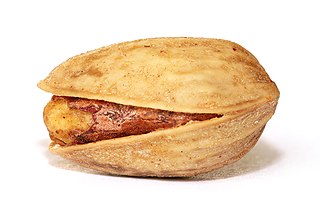
The pistachio, a member of the cashew family, is a small tree originating in Persia. The tree produces seeds that are widely consumed as food. The word can be countable or uncountable, meaning its plural is with or without an 's'.

Pistacia lentiscus is a dioecious evergreen shrub or small tree of the genus Pistacia native to the Mediterranean Basin. It grows up to 4 m (13 ft) tall and is cultivated for its aromatic resin, mainly on the Greek island of Chios, around the Turkish town of Çeşme and northern part of Iraq

Pistacia is a genus of flowering plants in the cashew family, Anacardiaceae. It contains 10 to 20 species that are native to Africa and Eurasia from the Canary Islands, all of Africa, and southern Europe, warm and semidesert areas across Asia, and North America from Guatemala to Mexico, as well as southern Texas.

The Anacardiaceae, commonly known as the cashew family or sumac family, are a family of flowering plants, including about 83 genera with about 860 known species. Members of the Anacardiaceae bear fruits that are drupes and in some cases produce urushiol, an irritant. The Anacardiaceae include numerous genera, several of which are economically important, notably cashew, mango, Chinese lacquer tree, yellow mombin, Peruvian pepper, poison ivy, poison oak, sumac, smoke tree, marula and cuachalalate. The genus Pistacia is now included, but was previously placed in its own family, the Pistaciaceae.

Cotinus, the smoketree or smoke bush, is a genus of seven species of flowering plants in the family Anacardiaceae, closely related to the sumacs (Rhus).

Cotinus coggygria, syn. Rhus cotinus, the European smoketree, Eurasian smoketree, smoke tree, smoke bush, Venetian sumach, or dyer's sumach, is a Eurasian species of flowering plant in the family Anacardiaceae.

Pistacia terebinthus also called the terebinth and the turpentine tree, is a deciduous shrub species of the genus Pistacia, native to the Mediterranean region from the western regions of Morocco and Portugal to Greece and western and southeastern Turkey. At one time terebinths growing on the eastern shores of the Mediterranean Sea were regarded as a separate species, Pistacia palaestina, but these are now considered to be a synonym of P. terebinthus.

The comet moth or Madagascan moon moth. is a moth native to the rain forests of Madagascar. The species was first described by Félix Édouard Guérin-Méneville in 1847. The adult moth cannot feed and only lives for 4 to 5 days. Although endangered in the wild due to habitat loss, the comet moth has been bred in captivity.

The Illyrian deciduous forests is a terrestrial ecoregion in southern Europe, which extends along the eastern coast of the Adriatic Sea. It belongs to the Mediterranean forests, woodlands, and scrub biome, and is in the Palearctic realm.

Ophiusa tirhaca, the green drab, is a moth of the family Erebidae. The species was first described by Pieter Cramer in 1777. It is found in southern Europe, Africa, Australia and the southern parts of Asia.

Akbesia is a monotypic moth genus in the family Sphingidae erected by Walter Rothschild and Karl Jordan in 1903. Its only species, Akbesia davidi, the pistacia hawkmoth, was first described by Charles Oberthür in 1884. It is known from southern Turkey, northern Syria, northern Israel, western Jordan, south-eastern Turkey, north-eastern Iraq, south-eastern Georgia, northern Iran, eastern Afghanistan and Iranian Beluchistan. It may also occur across Azerbaijan, the Alborz Mountains of northern Iran, the Zagros Mountains of western and southern Iran, and northern Afghanistan. It often occurs in large numbers at certain sites in rocky, hilly areas supporting scattered trees and shrubs of Quercus, Olea, Ceratonia and Pistacia.

The Tyrrhenian-Adriatic sclerophyllous and mixed forests is an ecoregion in southern Italy, Sicily, Sardinia, Corsica, the Dalmatian Islands of Croatia, and Malta.

Pistacia atlantica is a species of pistachio tree known by the English common name Mt. Atlas mastic tree, Atlas pistachio, Atlantic pistacio, Atlantic terebinth, Cyprus turpentine tree, and Persian turpentine tree.

Mastic is a resin obtained from the mastic tree. It is also known as tears of Chios, being traditionally produced on the island Chios, and, like other natural resins, is produced in "tears" or droplets.

Acalyptris minimella is a moth of the family Nepticulidae. It is widespread and common in the western Mediterranean region, usually not far from the sea. It has been recorded from Portugal, Spain, France, Italy, Croatia, Ibiza, Mallorca, Corsica, Sardinia and Sicily. It is also present in North Africa, where it has been recorded from Morocco, Algeria and Tunisia.

Acalyptris pistaciae is a moth of the family Nepticulidae. It is found in the eastern Mediterranean region, where it is widespread in Greece, Cyprus and Turkey. It is probably also present in Syria and Lebanon. Mines collected in Israel in 1931 and identified as Simplimorpha promissa may also belong to be this species.

Anacardioideae is a subfamily of plants in the family Anacardiaceae.

Pistacia integerrima is a species of pistachio tree native to Asia, commonly called zebrawood. It is often classified as Pistacia chinensis ssp. integerrima. It is used for a variety of purposes in India, including timber, dye, and fodder. The leaf galls are used in traditional herbalism for cough, asthma, fever, vomiting, and diarrhea.
Khojir National Park is the oldest protected area in Iran, located on the southern slopes of the Alborz Mountains east of Tehran in Tehran Province. It was established as a wildlife reserve in 1979 and promoted to national park in 1982. It covers 99.71 km2 (38.50 sq mi) in the Jajrood River basin and ranges in altitude from 1,200 to 2,200 m.
Pistacia eurycarpa, commonly as Persian turpentine tree, is a species of Pistacia native to southeastern Turkey, northern Iraq, Iran, Armenia, and Antilebanon. It is called qezwan (قەزوان) or dareben (دارەبەن) in Kurdish. It is morphologically close to Pistacia atlantica subsp. mutica, but differs by having distinctly compressed fruits.


















